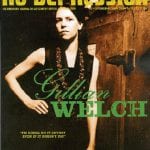John Lee Hooker: 1917 to 2001
Writing in a 1998 issue of the Village Voice, Robert Christgau adduced that John Lee Hooker, who died in his sleep on June 21, was nearly 140 years old. The bluesman was only 80 at the time, which Christgau of course knew, but his droll assessment was true just the same: Hooker sounded at least 140, and often a whole lot older than that. So atavistic were his riffing and moaning — droning vamps not bound by the requisite twelve-bar chord progressions or AAB lyric-schemes of the blues — that they might as well have emanated from the primeval heart of darkness itself.
Truth is, Hooker’s blues sprang from a world a whole lot less cabalistic than that — a world fraught, predictably enough for a black man of his generation, with hard work and harder lines, hardened hearts and even harsher realities. As much as anything else, that is why Hooker, who was born near Clarksdale, Mississippi, in 1917, has always sounded so old. Or at least since 1948, the year he cut his earliest sides in Detroit.
And yet the first of them, “Boogie Chillen”, was something of an exception. A high-spirited slice of ghetto verite galvanized by the lines, “One night I was layin’ down/I heard mama ‘n’ papa talkin’/I heard papa tell mama/’You better let that boy boogie-woogie,'” the record consisted of nothing but a juking, one-chord guitar figure and Hooker’s incantatory vocals. It was also an instant classic, an R&B smash (even at a time when solitary blues singers like him were passe), no doubt because it reverberated with the sense of possibility that pervaded postwar America and, before long, would incite the first stirrings of the Freedom Movement.
Other early hits, such as the reverb-drenched “Crawling Kingsnake Blues” and “I’m In The Mood”, brimmed with much the same sense of anticipation, but they also oozed danger, a feeling born of the awareness that freedom always exacts its price.
In other words, for all the talk of how primitive — elemental as mud — Hooker’s music was, he was also a modern, and incontrovertibly so. Urban wit, awareness, and intensity coursed through his recordings; some, such as 1948’s “War Is Over (Goodbye California)” and 1967’s “The Motor City is Burning”, even engaged in outright social and political commentary. Hooker’s early unaccompanied sides, on which his feet often stomped out irregular rhythms on a sheet of well-miked plywood, likewise betrayed a modernist streak, anticipating developments in rock ‘n’ roll that were still a good decade away. “Like those of Robert Johnson,” wrote critic Charles Shaar Murray, “Hooker’s solo performances are virtual blueprints of how the song could be arranged for a rock band.”
Hooker himself didn’t start working with a band until the mid-’50s, when he signed with Chicago’s Vee-Jay label, for which singles such as “Boom Boom” and “Dimples” not only became best-selling hits, but staples in the set lists of bar bands everywhere. Still, apart from a unit that included labelmates Eddie Taylor on guitar and Jimmy Reed on harp, none of these combos proved a good match for Hooker’s preternaturally intuitive approach to the blues.
His myth nevertheless grew, particularly among rockers, who embraced him as an icon and elder statesman, the incarnation of High John the Conqueroo himself. Along the way, everyone from the Animals and Them to Canned Heat and ZZ Top cut his songs and/or recorded with him. Later in his career, Hooker won Grammies, worked with the likes of Bonnie Raitt, Los Lobos, and Carlos Santana, even made it into the Rock Hall of Fame. Through it all, he remained deep, dark, and imperious, dignity and self-possession ringing from every note he sang and played.




